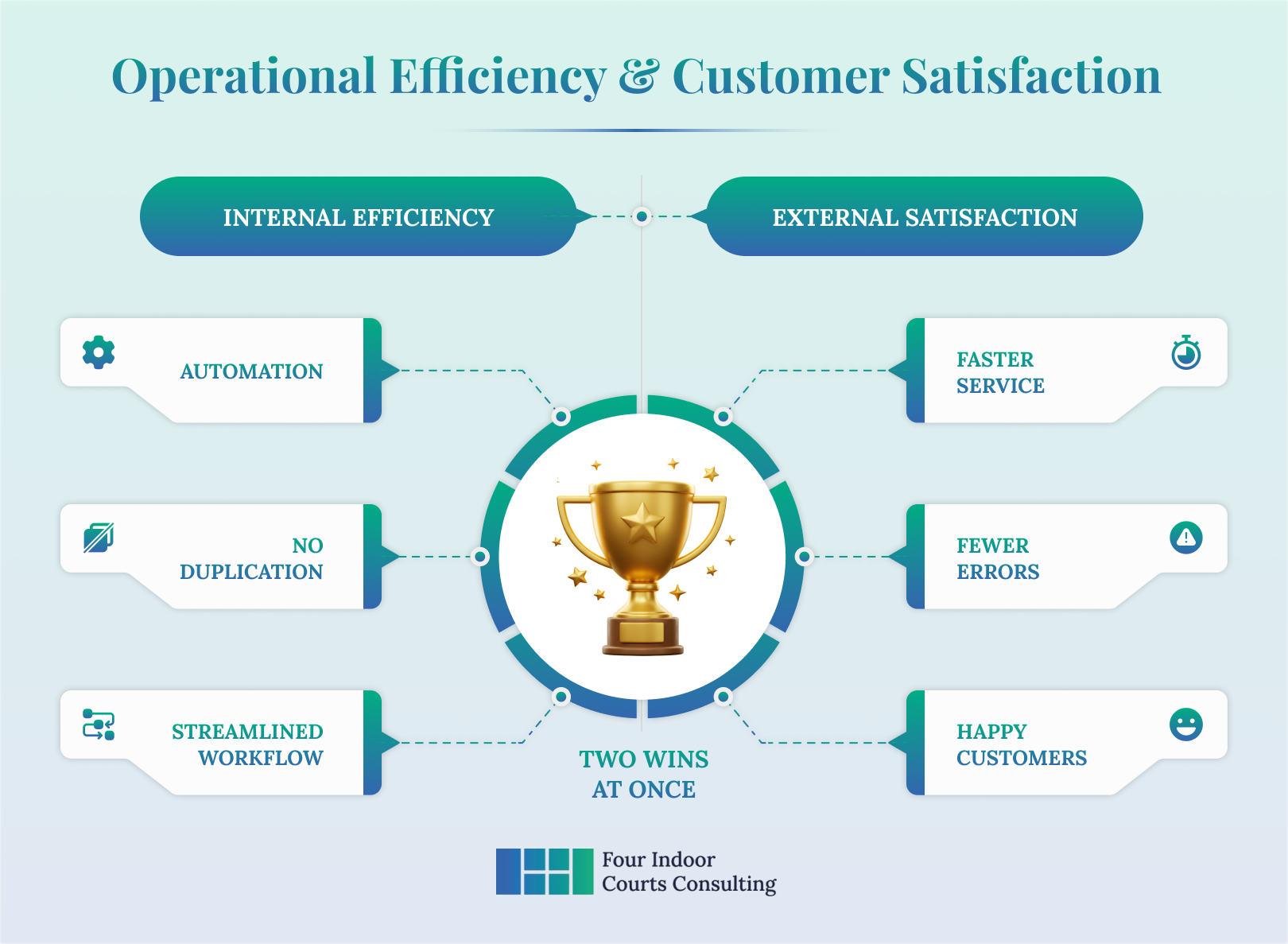Understanding Process Optimization and Its Goals

What Is Process Optimization?
At its core, process optimization is the practice of analysing your current processes - how tasks get done, how decisions are made, how work moves through your business - and redesigning them to be leaner, faster, and more effective.
It means identifying ways to streamline operations by eliminating wasted effort, removing bottlenecks, and creating systems that support both the business needs and the founder.
As we often explain at FICC:
“Process optimization is fractional leadership that grows your business and gives you your life back.”
Because while efficiency matters, the real goal is balance: a thriving business that doesn’t consume you.
Pain → Promise → Payoff
- Pain: Overloaded, working 60+ hours, no time for family or peace of mind.
- Promise: Fractional leadership that grows your business while lifting the burden.
- Payoff: A thriving business and a life outside it. Growth without burnout.
Improving Operational Efficiency and Customer Satisfaction

Every founder knows that inefficiency behind the scenes eventually shows up in front of customers. Long response times, missed deadlines, inconsistent service - these are the tell-tale signs of broken processes.
Optimization - delivered with the human intervention of Leah Norris at FICC, delivers two wins at once:
- Operational efficiency: workflows become streamlined, duplication disappears, manual tasks get automated.
- Customer satisfaction: fewer errors, faster service, better experiences.
For the Drowning Founder, this can mean finally having a trusted partner who steps in with extra eyes and hands. For the Stretched Visionary, it means reclaiming evenings with family while customers notice a smoother, more reliable service.
And for the Scaling Operator, it’s about having the confidence that their team and systems can keep up with ambitious expansion plans. For the Plateaued Professional, it means breaking through stagnation with a fresh approach that uncovers new opportunities for growth.
Often, customer satisfaction becomes the canary in the coal mine. When clients complain or churn rises, it’s rarely about the product itself — it’s about the experience wrapped around it. Process optimization ensures every touchpoint, from enquiry to delivery to aftercare, is consistent and seamless - and continuous improvement is built in.
Streamlining Business Operations and Reducing Costs
When leaders hear “cost reduction,” they often think of cuts. In reality, process optimization reduces cost by removing unnecessary steps and redirecting energy into value-adding work.
That’s why our growth-focused clients see process optimization as a way to sharpen strategy and protect margins, not just to save pennies. It’s not austerity - it’s smart design.
For example, one professional services client discovered through FICC’s mapping that three different staff members were touching the same client file before it reached the partner’s desk. By simplifying the workflow and introducing better document management, they reduced wasted time by 40% and freed up capacity for billable work. Cost went down - revenue went up.
Pain → Promise → Payoff
- Pain: Buried in day-to-day firefighting; feels no control or headspace.
- Promise: We’re your second set of eyes, expert hands, and sounding board.
- Payoff: Relief, clarity, and confidence with a trusted partner beside you.
Eliminating Inefficient Processes and Unnecessary Steps
One of the most common moments in FICC comes when we map a client’s current process flow. Suddenly the founder sees the reality: duplicated approvals, data re-entered in three different systems, critical tasks stuck in email inboxes and often, low employee satisfaction too.
For a moment there’s silence, then a knowing laugh - followed by fear and urgency. Because once inefficiency is visible, it can’t be ignored.
That’s the power of process optimization: shining a light on what’s really happening, then redesigning for clarity and flow.
And crucially, at FICC we don’t just hand you a map and walk away. We roll up our sleeves and co-create the fixes with you - whether that’s documenting clearer roles, setting up dashboards, or mentoring your colleagues so they can carry the improvements forward.
This is where culture and morale often shift too. When employees see friction removed and workloads made easier, they become allies of change rather than blockers.
The Goals of Process Optimization

Every optimization effort should serve clear goals. At FICC, we focus on three:
- Enhancing workflows and decision-making with real-time data
No more gut feel or paralysis. Leaders get dashboards and insights that guide action.
- Improving process efficiency to achieve business goals
Whether that’s faster onboarding, lower costs, smoother invoicing, or consistent delivery.
- Focusing on long-term growth and competitive advantage
By removing the operational drag that keeps founders stuck in the weeds.
“When you’re drowning in work, we lift you out - with senior leadership, hands-on delivery, and data tools to make sense of your business.”
Pain → Promise → Payoff
- Pain: Team at capacity; can’t scale without breaking systems.
- Promise: Flexible leadership support to cut through noise, set priorities, and deliver results.
- Payoff: Scalable growth with tools and leaders that stay beyond us.
Steps to Begin Business Process Optimization
Your First Step 1: Identify Areas for Improvement
We begin with pain points. For the Drowning Founder, it might be endless firefighting. For the Stretched Visionary, it’s working 60+ hours with no relief. For the Scaling Operator, it’s a team stretched beyond capacity. Each pain point points us to broken processes and helps identify the goal of process optimization.
Step 2: Conduct Process Mapping and Workflow Analysis
Looking at your existing processes, we then visualize how work really flows - not how people think it flows. This reveals hidden bottlenecks and duplication.
Step 3: Use Process Mining Tools to Analyse Data
Beyond mapping, data shows the real impact and can unpick complex processes: how long each step takes, where tasks get stuck, what errors cost. It's a root cause analysis.
Step 4: Address Root Causes with a Structured Approach
Instead of quick fixes, FICC tackles the underlying issues - missing systems, unclear responsibilities, poor data. With fractional leadership, we don’t just recommend; we implement. and you get very clear Key Performance Indicators from our work.
Often, this structured approach is where founders breathe a sigh of relief. For the first time in years, there is visibility, a clear roadmap, and the confidence that the business won’t collapse if they take a step back.
Benefits of Business Process Management

The outcomes are tangible:
- Streamlined operations: founders step back from firefighting and focus on strategy.
- Lower operational costs: wasted effort disappears, margins improve.
- Improved quality and fewer complaints: customers get a consistent experience.
- Time back for leaders: relief, clarity, and confidence replace exhaustion.
The payoff is clear: growth without burnout and a renewed sense of momentum. And perhaps most importantly, leaders rediscover why they started the business in the first place - freedom, impact, and the ability to choose how they spend their time.
Process Optimization Methods and Initiatives
Traditional and Holistic Approaches
FICC draws on proven methods with data-driven methodology, but tailors them for SMEs:
- Lean principles and TQM to cut waste.
- Value stream mapping to visualize inefficiency.
- Toyota Production System thinking to focus on flow and quality.
Technology-Driven Solutions
In 2025, digital transformation underpins optimization:
- Artificial intelligence and machine learning predict bottlenecks and forecast demand.
- Workflow automation logs decision points and handles repetitive tasks instantly.
- Data-driven decision-making creates specific processes and gives leaders confidence in every move.
This means finally having systems or a new process that scales. With your key processes in place, redundant steps removed, possibly some new technologies and good feedback loops, finally you're not shouldering every task alone.
And because FICC specializes in SMEs, we don’t overcomplicate. We translate enterprise-level ideas into practical, affordable solutions that work for a two, five, ten, or twenty-person team.
For example, we might bring in lightweight automation to a recruitment agency drowning in candidate admin, while for a tech scale-up the bigger win could be redefining product launch workflows to reduce friction between engineering and sales.
Examples and Use Cases of Process Optimization
Optimization is practical, not theoretical. Examples we see:
- Reducing cycle times: one client cut order fulfilment from 10 days to 3 by eliminating duplicate sign-offs.
- Streamlining service workflows: rerouting customer queries directly to the right team.
- Better resource utilization: moving staff from admin drudgery to revenue-generating roles.
- Automating repetitive tasks: invoices and reports generated automatically.
The result isn’t just efficiency. It’s freedom. Founders get their evenings back. Teams feel empowered. Customers notice the difference.
Pain → Promise → Payoff
- Pain: Drowning in work; business growth feels out of reach, resource allocation is mystery, your error rate is rising, and you might be starting to get customer complaints.
- Promise: We lift you, and if necessary, other team members out with senior leadership, agreed key steps, hands-on delivery, and data tools with a sensible ongoing process.
- Payoff: Your vision becomes reality; you're at maximum efficiency creating space to breathe while business moves forward and the bottom-line swells. You've got clear objectives and are enjoying better results.
Case Study: A Real 2025 Success Story

A mid-sized real estate firm hit a frustrating plateau. Despite pouring more money into paid marketing and expanding their sales team, new business leads weren’t converting. On paper, the equation should have worked: more spend + more people = more profit. But results stalled.
That’s when they turned to process optimization with FICC.
Instead of jumping straight into the weeds, we stepped back and reviewed the business end-to-end. With no internal bias, our role was to see the whole picture - not just one department - and pinpoint the less obvious blockers holding growth back.
The issue turned out not to be the volume of leads, but the way those leads were being handled. High-value prospects - acquired at significant cost - were getting stuck in the pipeline with salespeople who lacked the structure and support to close effectively.
By combining fractional leadership with hands-on delivery, FICC provided immediate relief. We trained, coached, and worked alongside the sales team to redesign their workflows, introduce clearer metrics, and remove friction in the handoff process.
The impact was rapid:
- Within one month, the expanded sales team began to convert at a higher rate, and the pipeline started to flow smoothly.
- Within two months, revenue picked up as previously stalled opportunities closed.
- Within three months, the cost per lead dropped significantly, transforming what had been an expensive plateau into a profitable growth curve.
For this client, the real breakthrough was clarity. The founder realized the problem wasn’t “not working hard enough” - it was broken processes. With structure, support, and optimization, the business didn’t just recover momentum - it unlocked a scalable, profitable future.
Challenges and Best Practices for Optimizing Processes
No optimization journey is smooth. Common challenges include:
- Resistance to change: staff fear disruption.
- Unclear objectives: without KPIs, optimization drifts.
- Balancing quick wins with long-term goals: founders want relief now and growth later.
- Sustaining momentum: improvement must be continuous, not one-off.
FICC addresses these by pairing strategic advice with hands-on delivery -guiding leaders through change while ensuring improvements stick.
We also focus heavily on change management for SMEs. It’s not enough to redesign a workflow; people need to buy into it. That means communication, training, and leadership support - all of which FICC builds into every engagement.
Key Insights for Successful Continuous Process
From working with founders and leaders of SMEs in all walks of life, from financial services to pet care, we’ve learned a few things about what competitive edge is built on (and it's not just quality of products!):
- Track what matters: focus on KPIs that drive outcomes, not vanity metrics.
- Fix root causes: don’t plaster over cracks; face the quality issues and know your customer needs.
- Embrace digital tools: data and automation amplify impact. Performance metrics are your friend.
- Commit to ongoing improvement: optimization is a management approach, not a project.
Most importantly: optimization is about people as much as processes. Founders need trusted partners - sounding boards, advisors, and hands-on support. Depending on your business type, the benefits of process optimization might be seen in process maps, or simply incremental changes, maybe better customer service or the discovery of an automation solution. Whatever the need, a fresh set of eyes can give you the objectivity needed for optimizing process. That’s the role FICC plays.
Conclusion: The FICC Difference
Process optimization isn’t just for corporates. For overwhelmed founders, stretched visionaries, and scaling operators, it’s the difference between burnout and balance, stagnation and growth.
At FICC, we bring fractional leadership, expert delivery, and data tools to lift you out of the overwhelm and move your business forward.
- For the Drowning Founder, it’s relief and clarity.
- For the Stretched Visionary, it’s growth without burnout.
- For the Scaling Operator, it’s scalable systems.
- For the Plateaued Professional, it’s fresh momentum.
In 2025, process optimization initiatives are no longer optional. It’s how ambitious businesses survive - and thrive.
If you’re ready to stop drowning in work and start scaling with confidence, FICC is here for you.



.jpg)

